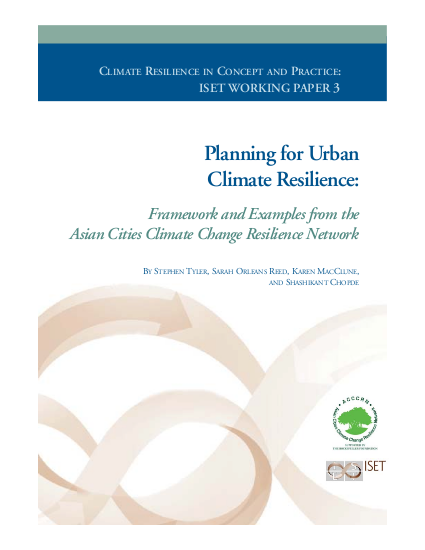
This paper summarizes and draws lessons from a great deal of interaction, analysis (including over 70 studies), and planning processes conducted in cities in Vietnam, India, and Indonesia as part of the Asian Cities Climate Change Resilience Network (ACCCRN). The ACCCRN program was conceived and initiated by the Rockefeller Foundation in 2008 and aims to catalyze attention, funding, and action for building climate change resilience for poor and vulnerable people in developing cities. Local partners from ten cities have engaged actively in this experimental process. In this paper, we draw key lessons about approaches, methods, and the practice of “urban resilience and “resilience planning” from their experiences. The cities discussed in this paper are Indore, Surat, and Gorakpur (India), Can Tho, Quy Nhon, and Da Nang (Vietnam), and Semarang and Bandar Lampung (Indonesia). We open our discussion by outlining the Urban Resilience Framework (URF). The URF is a conceptual framework for urban resilience that underlies the methodology introduced through the ACCCRN program. It emphasizes the role of systems and social agents (both internal and external) for building resilience in cities. Strengthening resilience, as described in the URF, includes building the capacity of agents to visualize and act, organize and reorganize, and learn; and the performance of systems with enhanced flexibility and diversity, redundancy and modularity; and that fail safely rather than catastrophically. To strengthen urban resilience, iterative processes of diagnosing vulnerability, planning, and implementation are required.
ACCCRN demonstrates one model for how this framework can be operationalized. We discuss in detail this process, which we have termed “resilience planning.” Through ACCCRN, ISET introduced a practical sequence of activities that utilizes inputs from climate projections, impact assessments, vulnerability assessments, detailed planning and sectoral studies, and pilot projects. Driving this approach were Shared Learning Dialogues (SLDs), a series of iterative multi-stakeholder workshops and discussions to generate interest and ownership, validate results of studies, and build a platform for collaborative action across diverse groups. In each instance, the ACCCRN process engaged a wide body of actors including government departments, academic institutions, communities, NGOs,
Although the processes of diagnosis, learning, and planning are highly iterative in the URF, a key milestone in ACCCRN was the production of a “City Resilience Strategy.” Resilience strategies are a novel tool, similar to climate adaptation action plans that are being developed in cities such as New York, Chicago, Durban, Cape Town, and Quito. As presented in the ACCCRN program, resilience strategies are a living document intended to provide context, evidence and analysis to justify actions for strengthening urban resilience, set priorities for action by local government, and provide background information to support greater awareness and autonomous adaptation by community and private organizations. ACCCRN cities were encouraged to recognize that resilience could be supported through a number of different approaches of varying cost and complexity, depending on the range of local conditions and priorities. The initial strategies generated a set of actions for building resilience, and then evaluated and prioritized them using locally-appropriate criteria and methods. In addition, the strategies show linkages and seek to influence existing development policies, procedures and plans, and create a platform for funding priority actions through local resources, senior governments, and external donors.
In this paper, we review the processes of resilience planning as actually implemented in 8 cities. This includes understanding how resilience planning can occur in a number of local and national contexts, the strengths and weaknesses of the methods introduced through ACCCRN, and key constraints and obstacles. We also draw lessons from the resilience strategies, which are the first documents of their kind to be developed locally in this type of process. The early strategies provide a glimpse into how “resilience” is being interpreted and practiced on a city level. Key observations and preliminary conclusions include:
Resource collections
- ALNAP focus topics
- Climate emergency
- Coordination
- Locally led humanitarian action
- Prioritisation
- UN Habitat - Urban Response Collection
- Urban Response - Urban Crisis Preparedness and Risk Reduction
- Urban Response Collection - Community Engagement and Social Cohesion
- Urban Response Collection - Economic Recovery
- Urban Response Collection - Environment and Climate Change
- Urban Response Collection - Housing, Land and Property
- Urban Response Collection - Urban Crisis Response, Recovery and Reconstruction
- Urban Response Collection - Urban Resilience